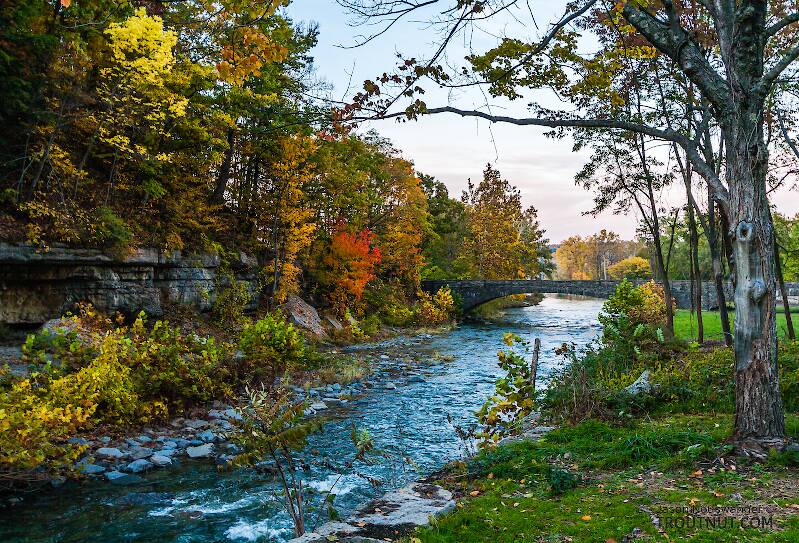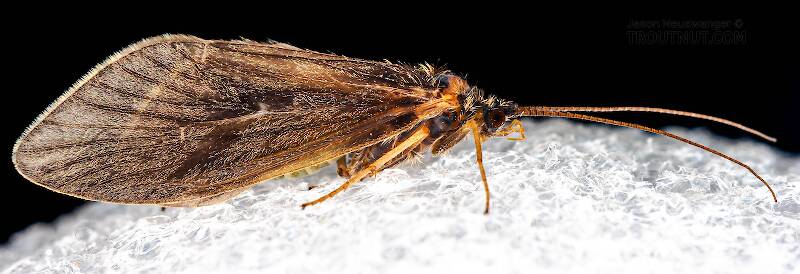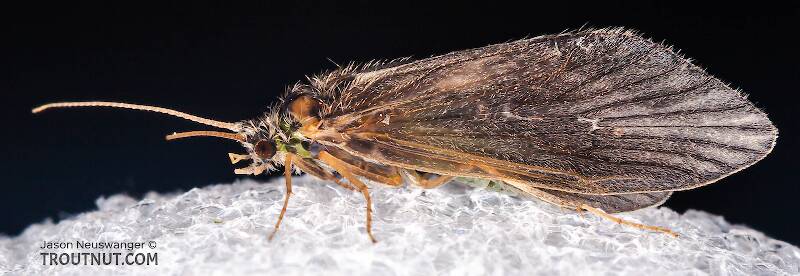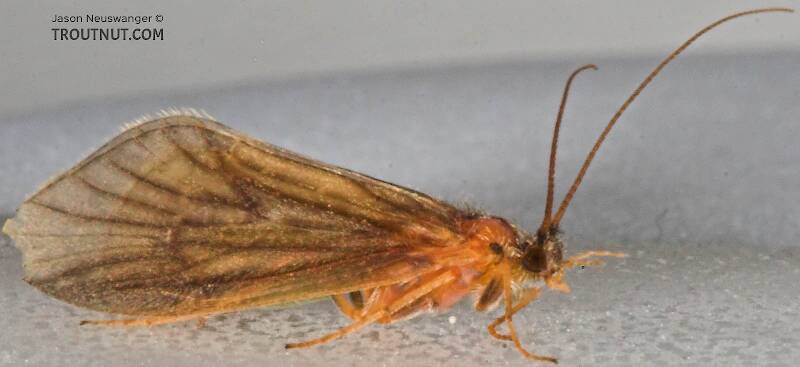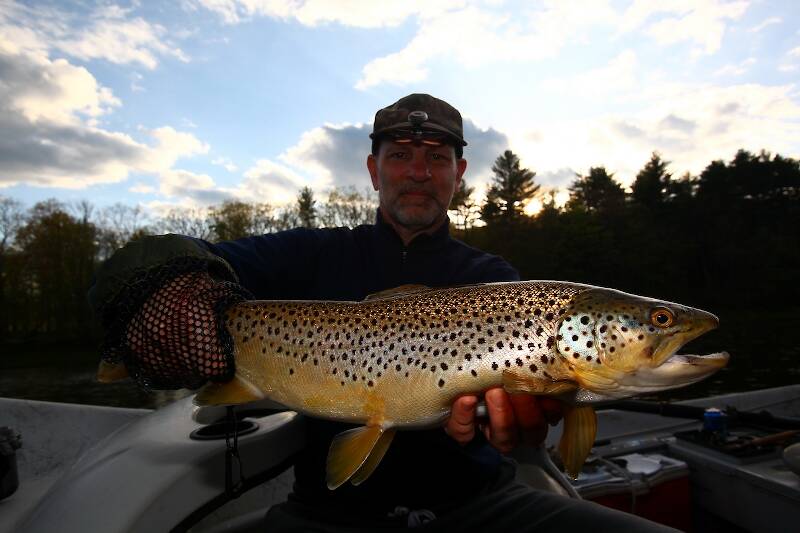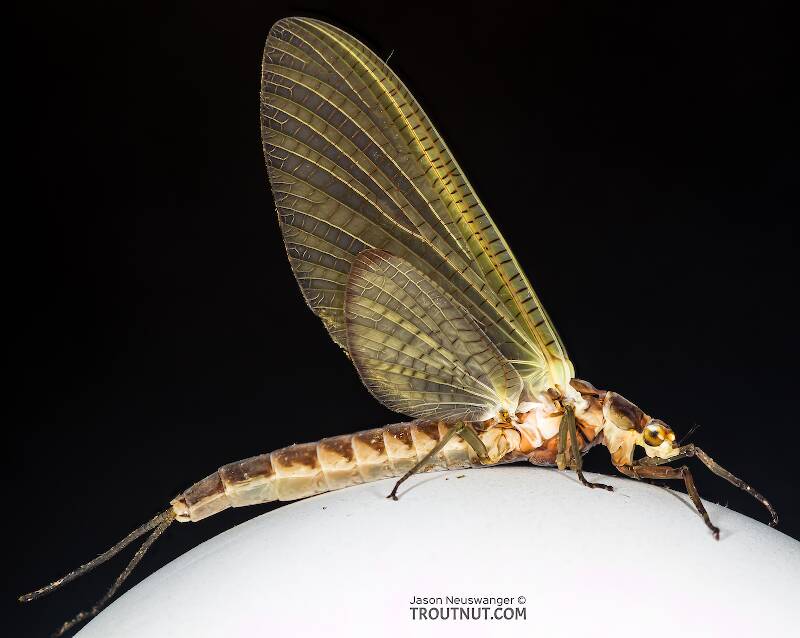
Hex Mayflies
Hexagenia limbata
The famous nocturnal Hex hatch of the Midwest (and a few other lucky locations) stirs to the surface mythically large brown trout that only touch streamers for the rest of the year.
Featured on the forum
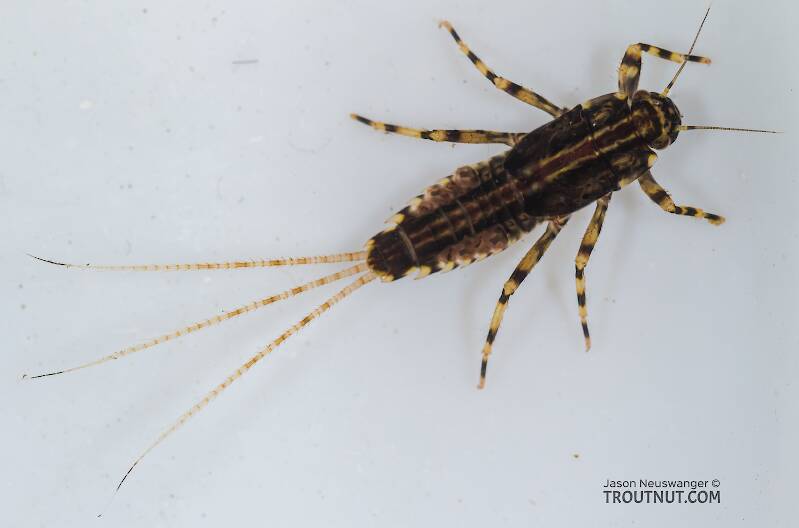
This is an interesting one. Following the keys in Merritt R.W., Cummins, K.W., and Berg, M.B. (2019) and Jacobus et al. (2014), it keys clearly to Ephemerella. Jacobus et al provide a key to species, but some of the characteristics are tricky to interpret without illustrations. If I didn't make any mistakes, this one keys to Ephemerella mucronata, which has not previously been reported any closer to here than Montana and Alberta. The main character seems to fit well: "Abdominal terga with prominent, paired, subparallel, spiculate ridges." Several illustrations or descriptions of this holarctic species from the US and Europe seem to match, including the body length, tarsal claws and denticles, labial palp, and gill shapes. These sources include including Richard Allen's original description of this species in North America under the now-defunct name E. moffatae in Allen RK (1977) and the figures in this description of the species in Italy.

Troutnut is a project started in 2003 by salmonid ecologist Jason "Troutnut" Neuswanger to help anglers and
fly tyers unabashedly embrace the entomological side of the sport. Learn more about Troutnut or
support the project for an enhanced experience here.
This topic is about the Caddisfly Family Brachycentridae
Brachycentrus is one of the most important caddisfly genera in America. Microsema is smaller and rarely, if ever, significant. Amiocentrus aspilus can be an important Western hatch.Example specimens
Grannom on Apr 29, 2007April 29th, 2007, 1:08 pm EDT
First, an introduction. I am 15 years old and live in Northwestern Pa. I have been reading the forums for quite a few years now, as they have helped me expand my knowledge.
I am interested in learning as much as possible about the grannom caddis. I would appreciate any information that you could offer about them, along with possible patterns and life cycle information. Thank you in advance.
Mike
I am interested in learning as much as possible about the grannom caddis. I would appreciate any information that you could offer about them, along with possible patterns and life cycle information. Thank you in advance.
Mike
"Be calm - you're there..." "...Tell yourself there's no rush, even if there is."
-John Gierach
-John Gierach
GONZO on Apr 29, 2007April 29th, 2007, 1:51 pm EDT
Hi Mike...and welcome aboard!
You might want to start by checking the thread entitled "grannom caddis" on the "Fly Hatch Talk..." board, then turn to the caddisfly section of Aquatic Insects (on the toolbar above) and click on Brachycentridae.
You might want to start by checking the thread entitled "grannom caddis" on the "Fly Hatch Talk..." board, then turn to the caddisfly section of Aquatic Insects (on the toolbar above) and click on Brachycentridae.
Troutnut on Apr 29, 2007April 29th, 2007, 2:58 pm EDT
What Gonzo said.
I moved this topic to the hatch talk section to make some of the links a little easier to find.
I moved this topic to the hatch talk section to make some of the links a little easier to find.
Jason Neuswanger, Ph.D.
Troutnut and salmonid ecologist
Troutnut and salmonid ecologist
Grannom on May 2, 2007May 2nd, 2007, 5:29 am EDT
Could anyone let me know the hatch times for NW Pa? I am almost possitive there is both a spring and fall hatch, and that I have missed the spring hatch, but let me know if you are aware. Thank you.
"Be calm - you're there..." "...Tell yourself there's no rush, even if there is."
-John Gierach
-John Gierach
Quillgordon on May 2, 2007May 2nd, 2007, 6:12 am EDT
Grannom,
I suggest you call a local 'fly shop' in the area where you intend to fish. They would know better than anyone else.
N.W. Pa. covers a large area with many streams/shops.
FWIW.......
Q.g.
I suggest you call a local 'fly shop' in the area where you intend to fish. They would know better than anyone else.
N.W. Pa. covers a large area with many streams/shops.
FWIW.......
Q.g.
Flyfishing is a state of mind! .............. Q.g.
C/R........barbless
C/R........barbless
RleeP on May 2, 2007May 2nd, 2007, 6:36 am EDT
Mike: Are you anywhere near the Sugar Creek drainage in Venango County or could you get there relatively soon?
This is the best and longest lasting Grannom hatch in your (and originally, my) part of the state. I grew up in southern Erie County, near Union City.
The bulk of it may be over now, but I'd bet that there will still be decent numbers of grannoms flitting around in the upper watershed, like the main stem near or above Bradleytown and in the branches that come out of Troy Center and Diamond respectively.
So, there may still be, for the next week perhaps an opportunity this spring to do some on-stream grannom research...:)
When I fished the grannnoms on Sugar, all I usually used was a size 14-16 dark-winged deer hair caddis with a very dark brown to black body and dark dun hackle. Or you can do well subsurface to emergers or oviposting flies with a simple soft hackle with a dark olive body and partridge hackle.
Good luck!
Lee
On Edit: Regarding hatch times or periods. Generally, the streams with decent Grannoms in the area (Sugar, Oil, Thompson Creek, trib to upper Oil near Hydetown and to a lesser extent the Pine/Caldwell drainage. There are others I'm sure, but i've been gone from there a while and forget..) will start to see bugs coming off arounf 4/20 as a general rule. It's usually over by the 5th of May or so. This can vary by up to a week in either direction though depending upon the progress of the Spring) Of the streams named, they come on Oil Creek first as a function of generally warmer water temps, then Thompson which is open and fairly shallow and warms quickly. Then Sugar and Pine. But generally, there isn't more than 3-4 days between the start on Oil and on the upper sections of Pine.
This is the best and longest lasting Grannom hatch in your (and originally, my) part of the state. I grew up in southern Erie County, near Union City.
The bulk of it may be over now, but I'd bet that there will still be decent numbers of grannoms flitting around in the upper watershed, like the main stem near or above Bradleytown and in the branches that come out of Troy Center and Diamond respectively.
So, there may still be, for the next week perhaps an opportunity this spring to do some on-stream grannom research...:)
When I fished the grannnoms on Sugar, all I usually used was a size 14-16 dark-winged deer hair caddis with a very dark brown to black body and dark dun hackle. Or you can do well subsurface to emergers or oviposting flies with a simple soft hackle with a dark olive body and partridge hackle.
Good luck!
Lee
On Edit: Regarding hatch times or periods. Generally, the streams with decent Grannoms in the area (Sugar, Oil, Thompson Creek, trib to upper Oil near Hydetown and to a lesser extent the Pine/Caldwell drainage. There are others I'm sure, but i've been gone from there a while and forget..) will start to see bugs coming off arounf 4/20 as a general rule. It's usually over by the 5th of May or so. This can vary by up to a week in either direction though depending upon the progress of the Spring) Of the streams named, they come on Oil Creek first as a function of generally warmer water temps, then Thompson which is open and fairly shallow and warms quickly. Then Sugar and Pine. But generally, there isn't more than 3-4 days between the start on Oil and on the upper sections of Pine.
Martinlf on May 2, 2007May 2nd, 2007, 7:35 am EDT
What helpful advice. One thing I wonder about, is there a fall Grannom hatch? I was under the impression that this is a once a year hatch in spring.
"He spread them a yard and a half. 'And every one that got away is this big.'"
--Fred Chappell
--Fred Chappell
Taxon on May 2, 2007May 2nd, 2007, 9:45 am EDT
Louis-
Out here in the West, we have a split emergence of those Brachycentrus species, which constitute a fishable hatch. Brachycentrus occidentalis emerges in April-May, and Brachycentrus americanus emerges in July-August. Perhaps it is this later emergence to which you refer.
Out here in the West, we have a split emergence of those Brachycentrus species, which constitute a fishable hatch. Brachycentrus occidentalis emerges in April-May, and Brachycentrus americanus emerges in July-August. Perhaps it is this later emergence to which you refer.
Martinlf on May 2, 2007May 2nd, 2007, 4:00 pm EDT
Roger, see Grannom's post above, May 2, (from Pennsylvania). I was responding to his comment.
"He spread them a yard and a half. 'And every one that got away is this big.'"
--Fred Chappell
--Fred Chappell
GONZO on May 13, 2007May 13th, 2007, 7:49 am EDT
Mike,
Lee's information on NW PA grannoms is very good, but he is also correct that the main grannom activity is probably over by now. You may find a few lingering on small cold streams, but these are not likely to be the large hatches you find earlier on the larger streams. The vast majority of PA grannnom hatches occur between mid-April and early May. Although there are several species involved, they all tend to peak somewhere in this period.
There is no fall grannom hatch. The later-hatching species that Roger mentions (B. americanus) is also found in the East, but I've never encountered it in PA, and it is more common in New England (but still not usually as heavy as the earlier grannoms).
The good news, however, is that we are entering one of the peak times for spotted sedge (Hydropsyche/Ceratopsyche) hatches and will soon be seeing the blue-winged sulphurs (E. invaria) in the late afternoon and evening. These hatches are very common throughout the state and bring some of the best fly-fishing of the season.
Lee's information on NW PA grannoms is very good, but he is also correct that the main grannom activity is probably over by now. You may find a few lingering on small cold streams, but these are not likely to be the large hatches you find earlier on the larger streams. The vast majority of PA grannnom hatches occur between mid-April and early May. Although there are several species involved, they all tend to peak somewhere in this period.
There is no fall grannom hatch. The later-hatching species that Roger mentions (B. americanus) is also found in the East, but I've never encountered it in PA, and it is more common in New England (but still not usually as heavy as the earlier grannoms).
The good news, however, is that we are entering one of the peak times for spotted sedge (Hydropsyche/Ceratopsyche) hatches and will soon be seeing the blue-winged sulphurs (E. invaria) in the late afternoon and evening. These hatches are very common throughout the state and bring some of the best fly-fishing of the season.
Flags on Apr 24, 2008April 24th, 2008, 6:25 am EDT
Mike: If you get a chance, thsi coming May 6th at 7pm there will be a major presentation on aquatic insects given by Mike Laskowski of Oil Creek Outfitters. It will be held at the Tom Ridge Center which is at the head of Presque Isle ( the Peninsula).
He will answer all of your questions on caddis, mays and stones.........
Regards,
Mike
He will answer all of your questions on caddis, mays and stones.........
Regards,
Mike
Stay focused on what is important in life...........
Grannom on Apr 26, 2008April 26th, 2008, 5:02 am EDT
Mike,
Thanks..I'm in McKean, so that's a quick drive. The Tom Ridge Center is really nice, if you haven't been. I will try to make it for sure. Thanks again.
Thanks..I'm in McKean, so that's a quick drive. The Tom Ridge Center is really nice, if you haven't been. I will try to make it for sure. Thanks again.
"Be calm - you're there..." "...Tell yourself there's no rush, even if there is."
-John Gierach
-John Gierach
Quick Reply
Related Discussions
Topic
Replies
Last Reply
2
Mar 24, 2011
by CaseyP
by CaseyP
8
Jun 16, 2013
by PaulRoberts
by PaulRoberts
2
Jul 9, 2018
by Martinlf
by Martinlf
11
Apr 14, 2007
by GONZO
by GONZO

